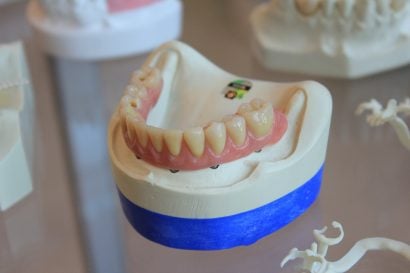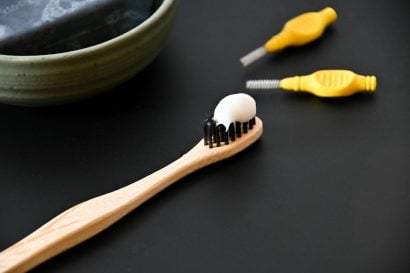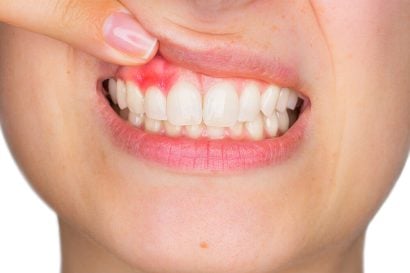What Is Enamel Erosion and Why It Happens in Thailand
Enamel erosion refers to the wearing away of the tooth’s enamel by frequent acid exposure. Over time, this process dissolves the protective outer layer of enamel and reveals the dentine underneath. When enamel erodes, it can lead to noticeable tooth sensitivity, changes in tooth color, and a higher risk of cavities or even tooth extraction in severe cases.
In Thailand, tooth erosion happens more often due to the combination of hot weather, dehydration, and a diet rich in acidic food and drinks. Unlike the five stages of tooth decay caused by bacteria, dental erosion occurs when acid comes directly into contact with the tooth surface, gradually breaking it down.
Common Causes of Enamel Erosion in Thailand
Recognizing the causes of enamel erosion can help you act early and protect your teeth:
Acidic Food and Drinks
- Tropical fruits, spicy dishes, and beverages like Thai iced tea can all cause erosion by introducing acid that dissolves the enamel. Frequent snacking or sipping means acid lingers longer, wearing away at enamel over time.
Acid Reflux Disease
- When stomach acid flows back into the mouth, known as acid reflux, it attacks the tooth’s enamel and can lead to significant enamel loss if untreated.
Dry Mouth and Dehydration
- Bangkok’s humid climate often causes dry mouth, reducing saliva production. Since saliva helps neutralize acid, less of it means the erosion usually progresses faster.
Teeth Grinding (Bruxism)
- Grinding can damage the tooth structure, and when combined with acid, it accelerates the loss of tooth enamel and may result in damaged teeth or cracks.
Eating Disorders Like Bulimia
- Frequent vomiting exposes teeth to stomach acid, gradually eroding the enamel and the dentine underneath. This is a leading cause of severe tooth enamel erosion.
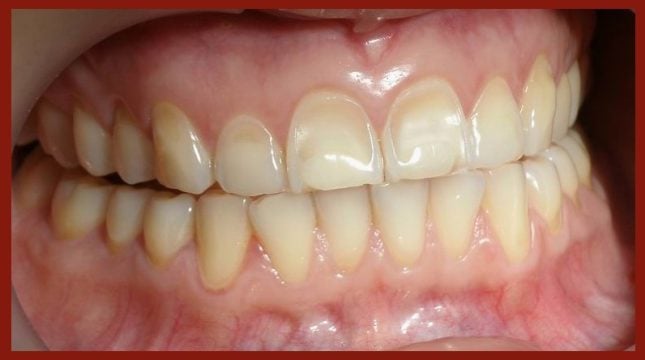
Close-up of dental erosion in a patient with hypoestrogenism.
Early Signs and Stages of Enamel Erosion
Enamel erosion develops in stages:
-
Earliest stages: Subtle sensitivity to temperature and sweets, and a slight dullness in tooth color.
-
Later stages: Thinning of the enamel layer, yellowing as dentine shows through, and small indentations on the biting surfaces.
-
Severe cases: Cracked enamel, uneven edges, and increased vulnerability to decay.
Noticing these signs and symptoms early gives you the best chance to protect the tooth and avoid more invasive treatments.
How Acid in Your Mouth Damages the Tooth Surface
Many people don’t realize that acid begins damaging the surface of your teeth almost immediately. With every sip of a carbonated drink or bite of sour fruit, acid dissolves minerals from the enamel surface. If you don’t allow saliva to rebalance your mouth, this process repeats and gradually erodes the enamel.
This constant exposure can cause erosion that leads to sensitivity, discoloration, and enamel loss. Over time, the enamel becomes so thin that the dentine underneath is unprotected, which may result in damage to tooth enamel that requires professional intervention.
Why Saliva Plays a Key Role in Preventing Dental Erosion
Healthy saliva flow acts as a natural defense against acid. It helps wash away particles, dilute acids, and deliver minerals that strengthen enamel.
If you often experience dry mouth, especially in Thailand’s heat, be mindful. Dehydration and low saliva levels mean acid stays in contact with the outer layer of enamel longer, increasing the risk of erosion.
To support saliva flow:
Maintaining saliva is one of the simplest ways to prevent dental erosion and keep enamel strong.
How to Prevent Enamel Erosion in Daily Life
A few daily habits can help prevent enamel erosion and protect the tooth surface:
-
Use a straw to reduce acid contact on your front teeth.
-
Rinse your mouth after meals to neutralize acid in your mouth.
-
Wait 30 minutes before you brush your teeth after consuming acidic food and drinks and use a good quality toothpaste.
-
Choose water instead of sweet drinks whenever possible.
-
Wear a night guard if you grind your teeth.
-
Use fluoride toothpaste and remineralizing mouthwash.
Practicing good oral hygiene and regular dental check-ups will help keep erosion from getting worse.
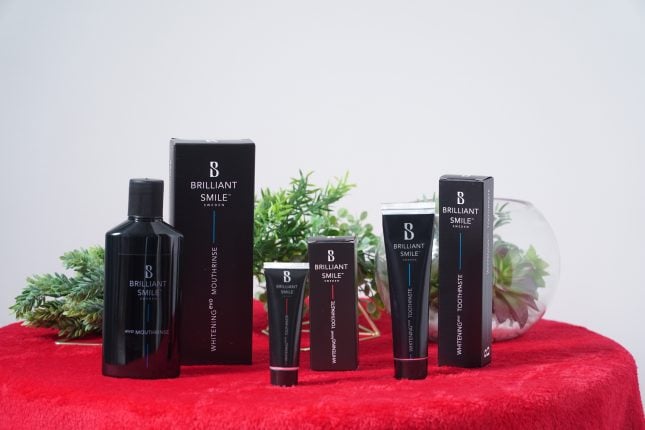
BrilliantSmile™ whitening products
Professional Treatment Options for Enamel Loss
When erosion advances beyond early stages, treatment of enamel erosion becomes essential. Dentists in Bangkok can recommend options like:
-
Fluoride applications to strengthen the remaining enamel and slow further damage.
-
Dental bonding to rebuild the worn tooth surface and restore appearance.
-
Porcelain veneers or crowns for extensive tooth enamel loss.
-
LED whitening systems that safely brighten teeth without harming enamel on teeth.
Addressing erosion early ensures less invasive procedures and better long-term outcomes.

Dentist assessing tooth shade for veneer placement
The Role of Fluoride in Protecting Enamel
Fluoride is a proven ally in preventing and reversing early stages of erosion. It helps replenish minerals lost during acid attacks and reinforces the layer of enamel.
To support enamel health:
-
Brush twice daily with fluoride toothpaste.
-
Use a fluoride mouthwash.
-
Avoid rinsing immediately after brushing so fluoride can protect the tooth’s enamel.
This approach helps prevent tooth decay and strengthens the tooth structure against future acid damage.
The Smile Bar: Gentle Whitening That Respects Enamel
At The Smile Bar in Bangkok, you’ll find a modern approach to cosmetic care that never compromises the health of your enamel surface. Our LED whitening treatments are designed to lift stains while preserving the enamel and the dentine underneath. Book a visit now !
Clients love the calming atmosphere and the confidence of knowing their dental health is in good hands.

After a Teeth Whitening Session at The Smile Bar Bangkok
Maintaining a Healthy Smile for the Long Term
By understanding the causes of tooth erosion, making small daily adjustments, and visiting your dentist regularly, you can prevent enamel erosion and avoid more extensive erosion treatment.
Protect your smile with smart choices, consistent care, and the support of trusted professionals in Bangkok.

Dental examination in progress.
Conclusion – TL;DR
Enamel erosion is a silent but serious threat to your smile—especially in Thailand, where heat, dehydration, and acidic foods speed up the damage. Early signs like sensitivity and yellowing are a warning to act fast.
Stay hydrated, limit acidic drinks, and brush with fluoride toothpaste. And if you notice signs of erosion, The Smile Bar Bangkok offers gentle whitening and partners with dental professionals to help restore and protect your enamel—so you can keep smiling with confidence.
Frequently Asked Questions
Is enamel erosion serious?
- Yes, enamel erosion is a serious condition if left untreated. Over time, it can lead to tooth sensitivity, decay, fractures, and even tooth loss. Seeking professional advice early allows for conservative treatments and helps maintain long-term oral health.
Can enamel erosion be reversed?
- In the early stages, enamel erosion can sometimes be halted or partially repaired through remineralization treatments such as fluoride applications and specialized toothpaste. However, once the enamel has worn away significantly, it does not grow back naturally. Dentists in Bangkok often recommend restorative solutions like bonding or veneers to protect the teeth and improve appearance.
How do you fix enamel erosion on teeth?
- Treatment depends on how advanced the erosion is. Mild cases may improve with fluoride treatments, dietary changes, and good oral hygiene. For more severe erosion, your dentist may use bonding to rebuild lost enamel, or place veneers and crowns to protect the tooth surface and restore function. A personalized treatment plan ensures the best outcome.
Where can I fix my dental erosion in Bangkok?
- You can find experienced cosmetic dentists and modern clinics across Bangkok that treat enamel erosion. Premium studios like The Smile Bar offer gentle whitening and work alongside dental professionals who provide fluoride treatments, bonding, and protective restorations to manage erosion. Booking a consultation with a dentist is the best way to create a personalized treatment plan.
What is the next step of dental erosion?
- If enamel erosion progresses without treatment, it can expose the dentine beneath the enamel. This stage often leads to increased sensitivity, visible yellowing, and a higher risk of tooth decay or fractures. Eventually, the tooth structure can weaken enough to require more advanced restorations such as crowns or veneers.
Is enamel erosion the same as a cavity?
- No, enamel erosion is different from a cavity. Erosion happens when acids gradually wear away the enamel surface, while cavities are caused by bacteria producing acid that creates holes in the tooth. Both conditions can damage your teeth over time, but they have different causes and require specific treatment approaches.
Credit : Dental erosion (hypoestrogenia)” by Mikael Häggström, MD – Wikimedia Commons






